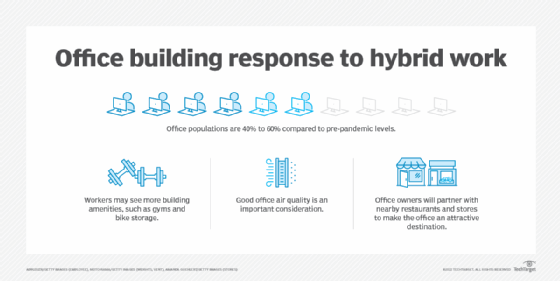Gone are the days when employees were expected to be in the office from 9 to 5. Since the pandemic, the office model has changed. Not only has it affected our personal lives but our working lives have been impacted. Companies are finding it harder to find employees who want to work in the office 5 days a week and employees are searching for jobs that give them a more flexible schedule with a work-life balance. Office building owners are looking for ways to entice their employees to work in the offices and some have even invested in amenities such as gyms, bike storage and game machines to help entice workers back to the office. Some are even offering child care to bring back women into the office!
“The number of people physically coming back to the office is still very disappointing,” said Fred Seigel, president and COO of Beacon Capital Partners, a Boston-based private real estate investment firm. The Real Estate Roundtable, a nonprofit public policy organization, sponsored the virtual forum.
But, Seigel noted, a positive sign for the future of offices is that the average lease term is seven years, indicating a commitment to using office space. “All that early conventional wisdom that businesses are only going to enter in the short-term leases — it was wrong,” he said.
Seigel said employers “need to communicate the advantages of in-person working, whether it’s better collaboration, driving more innovation, talent development.”
Thomas said he doesn’t know if hybrid work “is here to stay forever, but it’s certainly a reality of the market right now.”
By the end of this year, about 30% of office employees will work from home two or more days a week, said Kate Lister, president of Global Workplace Analytics, a telecommuting research and consulting firm in San Diego.

Remote worker fear
Working remotely also carries career risk. Remote workers can lose out on a promotion because they aren’t in the office. “Those working on-site first think of other colleagues on site for development opportunities, which cascades into remote colleagues missing out on promotions because they did not have the necessary opportunities to grow,”said Annika Jessen, an analyst in Gartner’s HR practice. Jessen said that business managers need to be aware of their bias against remote workers to avoid penalizing them.
In an office work model people are expected to be on the clock between 9 am and 5 pm every workday. In a hybrid work model, employees have more flexibility to get work done when they’re most productive. For example, some people work best early in the morning while others do better in the evening. They can also choose to work with teammates on-site or do heads-down work from a remote location. When employees have more control of their work schedules, they can free up time to take care of the things that crop up in their personal lives—whether it’s running an errand, picking up kids from daycare, or being home for a delivery. Working from home also cuts out the commute time which puts stress on some employees who drive from far locations.
In our survey, a majority (66%) of employees say they’re worried about their health and safety when it comes to returning to work. Fewer people in the workplace lowers the chance of a sick employee infecting others.
Another benefit is/…
In a hybrid work model, your company can hire talent from all around the globe. Having access to a wider talent pool means you can hire people with specialized skills. This can give your organization a competitive edge, help you move into new markets, and ensure around-the-clock productivity.
